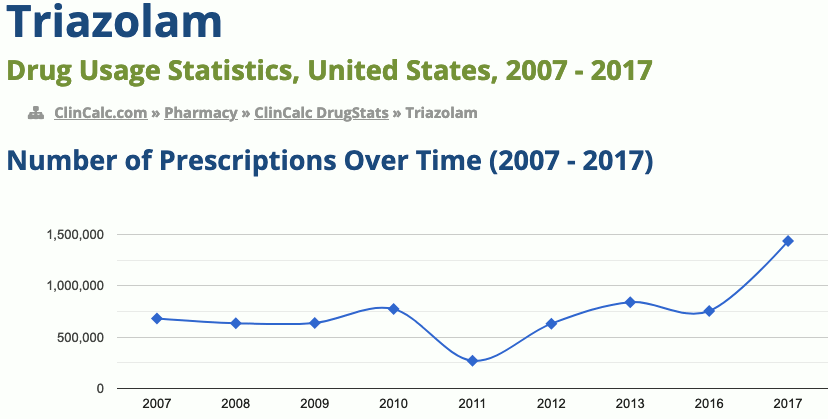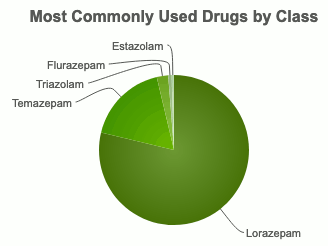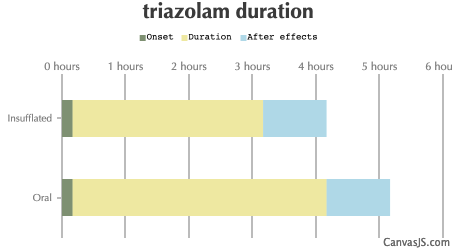[ Home ] [ Controlled Substances ] [ Depressants ]
TRIAZOLAM
|
Triazolam is a short-acting benzodiazepine used as a hypnotic agent in the treatment of insomnia. Some countries temporarily withdrew triazolam from the market because of concerns about adverse reactions, mostly psychological, associated with higher dose ranges. Its use at lower doses with appropriate care and labeling has been reaffirmed by the FDA and most other countries. Triazolam has a shorter half-life than chlordiazepoxide, flurazepam, and prazepam and does not generate active metabolites. Benzodiazepines bind nonspecifically to bezodiazepine receptors BNZ1, which mediates sleep, and BNZ2, which affects affects muscle relaxation, anticonvulsant activity, motor coordination, and memory. As benzodiazepine receptors are thought to be coupled to gamma-aminobutyric acid-A (GABAA) receptors, this enhances the effects of GABA by increasing GABA affinity for the GABA receptor. Binding of GABA to the site opens the chloride channel, resulting in a hyperpolarized cell membrane that prevents further excitation of the cell. Triazolam is used for the short-term treatment of insomnia. Triazolam`s original brand name is Halcion. Triazolam is withdrawn in the United Kingdom due to risk of psychiatric adverse drug reactions. This drug continues to be available in the U.S. Internationally, triazolam is a Schedule IV drug under the Convention on Psychotropic Substances.
 Triazolam:
Triazolam:
https://drugs.ncats.io/drug/1HM943223R

280th most prescribed medicine in the United States for 2017

https://clincalc.com/DrugStats/Drugs/Triazolam
Uses:
This medication is used to treat a certain sleep problem (insomnia). It may help you fall asleep faster, stay asleep longer, and lessen how often you wake up during the night, so you can get a better night's rest. Triazolam belongs to a class of drugs called benzodiazepines. It acts on your brain to produce a calming effect.Use of this medication is usually limited to short treatment periods of 1 to 2 weeks or less. If your insomnia continues for a longer time, talk to your doctor to see if you need other treatment.
Used for:
Difficulty sleeping
Before Using:
Tell your doctor or pharmacist your medical history, especially of:
- kidney disease
- liver disease
- lung/breathing problems (such as chronic obstructive pulmonary disease-COPD, sleep apnea)
- mental/mood problems (such as depression, thoughts of suicide)
- personal or family history of a substance use disorder (such as overuse of or addiction to drugs/alcohol)
- personal or family history of sleepwalking
- a certain muscle disease (myasthenia gravis)
Precautions:
Since this drug makes you drowsy, do not drive, use machinery, or do anything that needs alertness until you can do it safely.
Alcohol or marijuana (cannabis) can make you more drowsy.Avoid alcoholic beverages.
Talk to your doctor if you are using marijuana (cannabis).WARNINGS: Taking triazolam with opioid medications (such as codeine, hydrocodone) may increase your risk of very serious side effects, including death. To lower your risk, your doctor should have you take the smallest dose of triazolam that works, and take it for the shortest possible time.
Get medical help right away if any of these very serious side effects occur:
- Slow/shallow breathing
- Unusual lightheadedness
- Severe drowsiness/dizziness
- Difficulty waking up
User Reviews:
69 Total User Reviews Triazolam Oral Read Reviews Condition: Cronic Trouble Sleeping (45 Reviews): Effectiveness (3.76) Ease of Use (4.29) Satisfaction (3.47)
 Triazolam (Halcion):
Triazolam (Halcion):
https://www.webmd.com/drugs/2/drug-11213/triazolam-oral/details
Class Name: Sedative/Hypnotics

ESTAZOLAM | FLURAZEPAM | TRIAZOLAM | TEMAZEPAM | LORAZEPAM
Liver:
As with most benzodiazepines, triazolam therapy has not been associated with serum aminotransferase or alkaline phosphatase elevations, and clinically apparent liver injury from triazolam has been reported but is very rare.
Triazolam Hepatotoxicity:
Triazolam, like other benzodiazepines, is rarely associated with serum ALT elevations, and clinically apparent liver injury from triazolam is rare. There have been no well described case reports of acute liver injury from triazolam, except for a single report of a fatality after a severe and prolonged cholestatic liver injury. Cases of clinically apparent hepatitis have been reported with other benzodiazepines including alprazolam, chlordiazepoxide, clonazepam, diazepam, and flurazepam. The clinical pattern of acute liver injury from benzodiazepines is typically cholestatic and mild-to-moderate in severity with a latency of 1 to 6 months. Fever and rash are uncommon as is autoantibody formation.E Likelihood score: E (unlikely cause of clinically apparent liver injury).
 Triazolam Overview:
Triazolam Overview:
https://www.ncbi.nlm.nih.gov/books/NBK547843/
Important Information:
Do not use if you are pregnant.
Serious drug interactions can occur when certain medicines are used together with triazolam. Tell each of your healthcare providers about all medicines you use now, and any medicine you start or stop using.Avoid drinking alcohol. Dangerous side effects could occur.
Triazolam may impair your thinking or reactions. You may still feel sleepy the morning after taking triazolam. Wait until you are fully awake before you drive, operate machinery, or do anything that requires you to be awake and alert.Grapefruit and grapefruit juice may interact with triazolam and lead to unwanted side effects. Avoid the use of grapefruit products while taking triazolam.
Interactions:
Drug Interactions (442) Alcohol/Food Interactions (2) Disease Interactions (9)
What other drugs will affect Triazolam?
Taking triazolam with other drugs that make you sleepy or slow your breathing can cause dangerous side effects or death. Ask your doctor before taking a sleeping pill, narcotic pain medicine, prescription cough medicine, a muscle relaxer, or medicine for anxiety, depression, or seizures. Many drugs can interact with triazolam, and some drugs should not be used together. This includes prescription and over-the-counter medicines, vitamins, and herbal products. Not all possible interactions are listed in this medication guide. Tell your doctor about all medicines you use, and those you start or stop using during your treatment with triazolam. Give a list of all your medicines to any healthcare provider who treats you.A total of 442 drugs are known to interact with Triazolam.
- 50 major drug interactions
- 355 moderate drug interactions
- 37 minor drug interactions
 Triazolam Interactions:
Triazolam Interactions:
https://www.drugs.com/mtm/triazolam.html

https://erowid.org/experiences/subs/exp_Pharms_Triazolam.shtml
| Side Effects: |
| Get emergency medical help if you have signs of an allergic reaction: hives; difficulty breathing; swelling of your face, lips, tongue, or throat. |
|---|
| RxList |

Halcion (triazolam): https://www.rxlist.com/halcion-drug/patient-images-side-effects.htm |
Call your doctor at once if you have
|
| Some people using triazolam have engaged in activity such as driving, eating, making phone calls, or sleep-walking and later having no memory of the activity. If this happens to you, stop taking triazolam and talk with your doctor. |
| The sedative effects of triazolam may last longer in older adults. Accidental falls are common in elderly patients who take benzodiazepines. Use caution to avoid falling or accidental injury while you are taking triazolam. |
Common side effects may include:
|
| This is not a complete list of side effects and others may occur. Call your doctor for medical advice about side effects. You may report side effects to FDA at 1-800-FDA-1088. |
| Maximum Dosage: | |
|---|---|
| Prescribers Digital Reference | |

Halcion - Drug Summary: https://www.pdr.net/drug-summary/Halcion-triazolam-2361 | |
| Adults: | 0.5 mg/day PO. |
| Elderly | 0.25 mg/day PO. |
| Adolescents: | Safety and efficacy have not been established. |
| Children: | Safety and efficacy have not been established. |
| Black Box Warnings: |
|---|

Halcion (triazolam) (Rx): https://reference.medscape.com/drug/halcion-triazolam-342912 |
|
Concomitant use of benzodiazepines and opioids may result in profound respiratory depression, coma, and death; administer concomitantly when there are no alternative options; limit dosages and durations to minimum required; monitor for signs and symptoms of respiratory depression and sedation Addiction, abuse, and misuse
|
| Duration: An uncommon and very short acting benzodiazepine. Sedating and hypnotic, and may induce amnesia and lowered inhibitions at high doses. | |||
| Route | Onset | Duration | After Effects |
|---|---|---|---|
| Tripsit Factsheets | |||

Triazolam Basic Information: http://drugs.tripsit.me/triazolam | |||
| Oral: | 10-20 minutes | 4-7 hours | 1-6 hours |
| Insufflated: | 10-20 minutes | 3-5 hours | 1-6 hours |

| |||
| Effects: Anxiolytic, but primarily sedative or hypnotic. | |||
| Avoid: All other CNS depressants | |||
| Chemical Safety Summary: |
|---|
| INCHEM |
| Main risks and target organs: |
| Central nervous system, causing depression of respiration and consciousness. |
| Summary of clinical effects: |
| Central nervous system (CNS) depression and coma, or paradoxical excitation, but deaths are rare when benzodiazepines are taken alone. Deep coma and other manifestations of severe CNS depression are rare. Sedation, somnolence, diplopia, dysarthria, ataxia and intellectual impairment are the most common adverse effects of benzodiazepines. Overdose in adults frequently involves co- ingestion of other CNS depressants, which act synergistically to increase toxicity. Elderly and very young children are more susceptible to the CNS depressant action. Intravenous administration of even therapeutic doses of benzodiazepines may produce apnoea and hypotension. Dependence may develop with regular use of benzodiazepines, even in therapeutic doses for short periods. If benzodiazepines are discontinued abruptly after regular use, withdrawal symptoms may develop. The amnesia produced by benzodiazepines can have medico-legal consequences. |
| Diagnosis: |
| The clinical diagnosis is based upon the history of benzodiazepine overdose and the presence of the clinical signs of benzodiazepine intoxication. Benzodiazepines can be detected or measured in blood and urine using standard analytical methods. This information may confirm the diagnosis but is not useful in the clinical management of the patient. A clinical response to flumazenil, a specific benzodiazepine antagonist, also confirms the diagnosis of benzodiazepine overdose, but administration of this drug is rarely justified. |
| First aid measures and management principles: |
| Most benzodiazepine poisonings require only clinical observation and supportive care. It should be remembered that benzodiazepine ingestions by adults commonly involve co- ingestion of other CNS depressants and other drugs. Activated charcoal normally provides adequate gastrointestinal decontamination. Gastric lavage is not routinely indicated. Emesis is contraindicated. The use of flumazenil is reserved for cases with severe respiratory or cardiovascular complications and should not replace the basic management of the airway and respiration. The routine use of flumazenil is contraindicated because of potential complications, including seizures. Renal and extracorporeal methods of enhanced elimination are not effective. |
Pediatric:
Appropriate studies have not been performed on the relationship of age to the effects of triazolam in the pediatric population.Safety and efficacy have not been established.
Geriatric:
Appropriate studies performed to date have not demonstrated geriatric-specific problems that would limit the usefulness of triazolam in the elderly. However, severe drowsiness, dizziness, confusion, clumsiness, or unsteadiness are more likely to occur in the elderly, which may require an adjustment in the dose for patients receiving triazolam.
 Triazolam (Oral Route) (Halcion):
Triazolam (Oral Route) (Halcion):
https://www.mayoclinic.org/drugs-supplements/triazolam-oral-route/description/drg-20072203
Breastfeeding:Summary of Use During Lactation:
Because little information is available on the use of triazolam during breastfeeding, an alternate hypnotic may be preferred, especially while nursing a newborn or preterm infant. Triazolam has a relatively short half-life, so occasional use while breastfeeding an older infant should pose little risk to the infant, but monitor the infant for excessive drowsiness.Effects in Breastfed Infants:
In a telephone follow-up study, 124 mothers who took a benzodiazepine while nursing reported whether their infants had any signs of sedation. One mother took triazolam while breastfeeding and reported no sedation in her infant.Alternate Drugs to Consider:
 Triazolam Drug Levels and Effects:
Triazolam Drug Levels and Effects:
https://www.ncbi.nlm.nih.gov/books/NBK501261/
Triazolam : Interaction with Foods, Herbs & Alcohol - Difficulty in initiating and maintaining sleep is known as insomnia. It is a symptom that occurs due to other disorders and can cause daytime sleepiness. Top 10 Ways to Prevent Jet Lag | ... Wednesday May 24, 2023 - medindia.net What Drugs Did Jeffrey Dahmer Use On His Victims Before Killing Them? Halcion And Triazolam, Explained - Infamous serial killer Jeffrey Dahmer and his brutal crimes may have occurred more than two decades ago, but Netflix's newest limited series, Monster: The Jeffrey Dahmer Story, is bringing up the ... Triazolam - Indications, Dosage, Side Effects and Precautions - Discover comprehensive details about Triazolam, including its pronunciation, uses, dosage instructions, indications, and guidelines on how and when to take it or avoid it. The updated prescription ... Relative Abuse Liability of GHB in Humans: A Comparison of Psychomotor, Subjective, and Cognitive Effects of Supratherapeutic Doses of Triazolam, Pentobarbital, and GHB - Although preclinical studies suggest that GHB has low likelihood for abuse, case reports indicate that GHB is abused. This study evaluated the relative abuse liability of GHB in 14 volunteers with ... Effects of Triazolam on Brain Activity During Episodic Memory Encoding: A PET Study - Nine adult volunteers (four male) participated. Three of these participants did not complete the second of the two experimental sessions: two (one male and one female) because of cyclotron failure ...
| ||
| Depressants | Link to this page |






